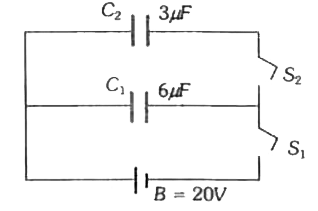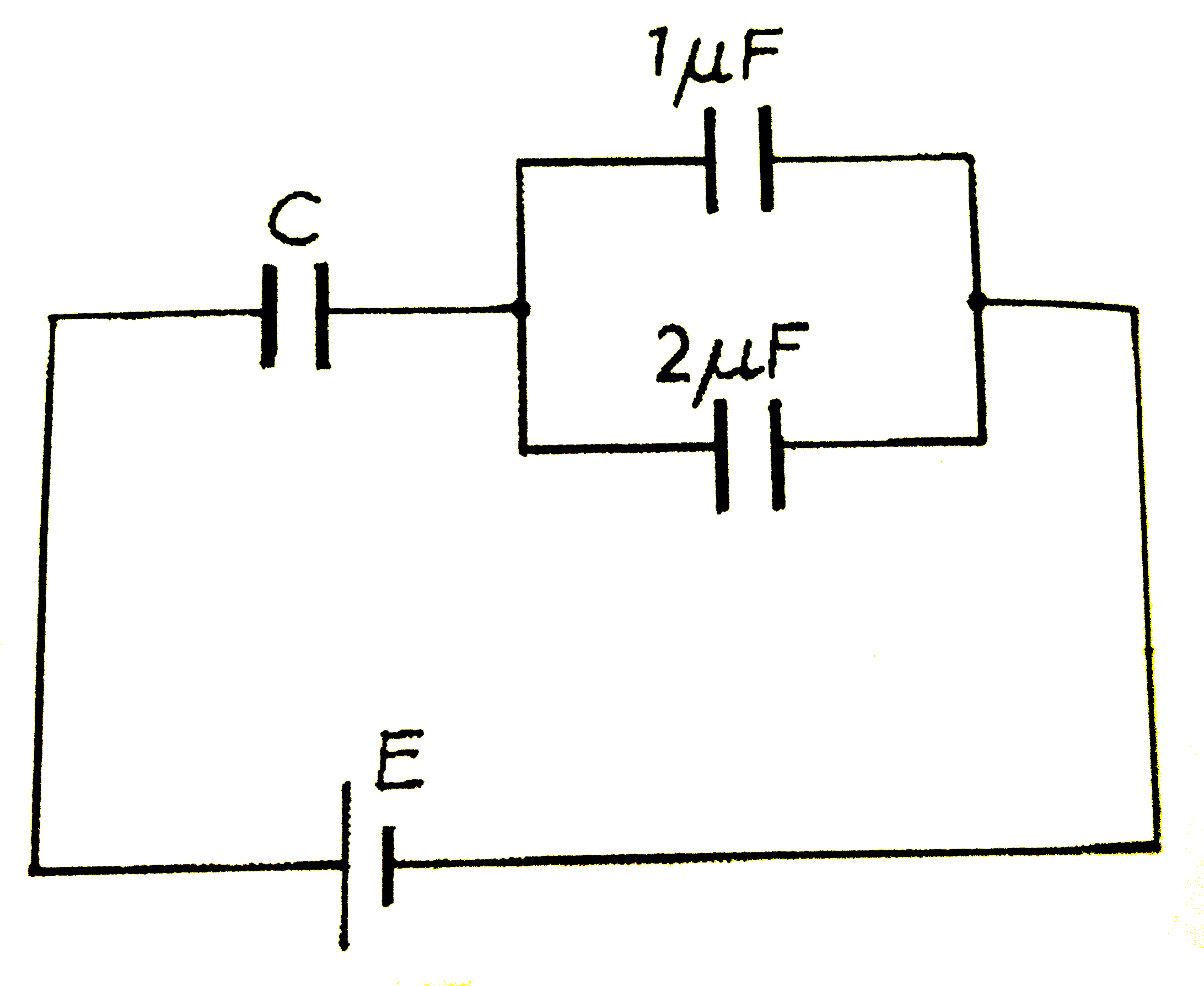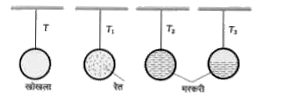यहाँ दिखाये गये परिपथ में C1=6μF,C2=3μF और बैटरी B = 20V स्विच S1 को पहले बन्द करते हैं | फिर S1 को खोलकर S2 को बन्द कर देते हैं | अन्ततः C2 पर कितना आवेश होगा

120μC
80μC
40μC
20μC
The correct Answer is:C
उभयनिष्ठ विभव V=6×20+3×0(6+3)=1209 Volt
अतः 3μF संधारित्र पर आवेश
Q2=3×10−6×1209=40μC
Topper's Solved these Questions
- स्थिर वैद्युतBook:ERRORLESS HINDIChapter:स्थिर वैद्युतExercise:Critical Thinking
Explore 109 Videos
- स्थिर वैद्युतBook:ERRORLESS HINDIChapter:स्थिर वैद्युतExercise:Graphical Questions
Explore 13 Videos
- स्थिर वैद्युतBook:ERRORLESS HINDIChapter:स्थिर वैद्युतExercise:Ordinary Thinking (धारिता)
Explore 128 Videos
- सरल आवर्त गति Book:ERRORLESS HINDIChapter:सरल आवर्त गति Exercise:Self Evaluation Test (सरल आवर्त गति )
Explore 19 Videos
Similar Questions
दो समान ऋण आवेश q , q, Y- अक्ष पर बिन्दुओं (0 , a) तथा (0 , -a) पर स्थित हैं | एक धन आवेश Q, X- अक्ष पर बिन्दु (2a, 0 ) पर विरामावस्था से मुक्त किया जाता है | आवेश Q
View Solutionदिए गये परिपथ में, C के मान के 1μF से 3μF परिवर्तित होने से, 2μF संधारित्र पर आवेश Q2 में परिवर्तन होता है। के पहलन के रूप में Q2 को कौन-सा आलेख सही दर्शाता है? (आलेख केवल व्यवस्था आरेख है और स्केल के अनुसार नहीं है।)

View Solutionएक आवेशित समांतर प्लेट संधारित्र की स्थितिज ऊर्जा U0 है | यदि प्लेटों के मध्य एक k परावैद्युतांक पदार्थ की पट्टिका रख दी जाती है तो संधारित्र की नई स्थितिज ऊर्जा होगी
View Solutionएक सरल लोलक , का गोलक एक धात्विक खोकला गोला है। इसका आवर्तकाल T है। जब गोलक में रेत भरी है। तब आवर्तकाल T1 है जब यह मरकरी से भरा है तब आवर्तकाल T2 है जब यह मरकरी से आधा भरा है तब इसका आवर्तकाल T3 है । तब निम्न में से सही विकल्प है।

View SolutionGiven, sn=1+q+q2+.....+qn,Sn=1+q+12+(q+12)2+...+(q+12)n,q≠1 prove that n+1C1+n+1C2s1+n+1C3s2+......+n+1Cn+1sn=2nSn.
View Solutionif S_(n)=C_(0)C_(1)+C_(1)C_(2)+...+C_(n-1)C_(n) and (S_(n+1))/(S_(n))=(15)/(4) then n is
View SolutionIn the circuit shown here C_(1) = 6muF, C2 = 3muF and battery B = 20V . The Switch S_(1) is first closed. It is then opened and afterwards S_(2) is closed. What is the charge finally on C_(2)
View SolutionTwo capacitors C_(1)"and"C_(2) are charged to the same potential V, but with opposite polarity as shown in the figure. The switch S_(1)"and"S_(2) are then closed.
View SolutionTwo capacitors C_(1) and C_(2) are charged to same potential V , but with opposite polarity as shown in the figure. The switches S_(1) and S_(2) are then closed
View SolutionIf Sn=(.nC0)2+(.nC1)2+(.nCn)n, then maximum value of [Sn+1Sn] is _____.
(where [⋅] denotes the greatest integer function)
View SolutionLet each of the circles
S1≡x2+y2+4y−1=0
S1≡x2+y2+6x+y+8=0
S3≡x2+y2−4x−4y−37=0
touch the other two. Also, let P1,P2 and P3 be the points of contact of S1 and S2,S2 and S3, and S3 , respectively, C1,C2 and C3 are the centres of S1,S2 and S3 respectively.
The coordinates of P1 are
View SolutionLet each of the circles,
S1=x2+y2+4y−1=0,
S2=x2+y2+6x+y+8=0,
S3=x2+y2−4x−4y−37=0
touches the other two. Let P1,P2,P3 be the points of contact of S1andS2,S2andS3,S3andS1 respectively and C1,C2,C3 be the centres of S1,S2,S3 respectively.
Q. The co-ordinates of P1 are :
View SolutionLet each of the circles,
S1=x2+y2+4y−1=0,
S2=x2+y2+6x+y+8=0,
S3=x2+y2−4x−4y−37=0
touches the other two. Let P1,P2,P3 be the points of contact of S1andS2,S2andS3,S3andS1 respectively and C1,C2,C3 be the centres of S1,S2,S3 respectively.
Q. The ratio area(ΔP1P2P3)area(ΔC1C2C3) is equal to :
View SolutionLet each of the circles,
S1=x2+y2+4y−1=0,
S2=x2+y2+6x+y+8=0,
S3=x2+y2−4x−4y−37=0
touches the other two. Let P1,P2,P3 be the points of contact of S1andS2,S2andS3,S3andS1 respectively and C1,C2,C3 be the centres of S1,S2,S3 respectively.
Q. P2andP3 are image of each other with respect to line :
View SolutionHave given S_(n)=1+q+q^(2)+.....+q^(n) , S_(n)=1 +(q+1)/(2)+((q+1)/(2))^(2)+....+((q+1)/(2))^(n), q ne 1 Then prove that ""^(n+1)C_(1)+""^(n+1)C_(2)S_(1)+""^(n+1)C_(3)S_(2)+.....+""^(n+1)C_(n+1) S_(n)=2^(n)S_(n)
View SolutionIf Sn=(.nC0)2+(.nC1)2+(.nCn)n, then maximum value of [Sn+1Sn] is _____.
(where [⋅] denotes the greatest integer function)
View Solution
